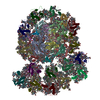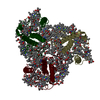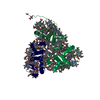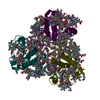+Search query
-Structure paper
| Title | The photosystem I supercomplex from a primordial green alga harbors three light-harvesting complex trimers. |
|---|---|
| Journal, issue, pages | Elife, Vol. 12, Year 2023 |
| Publish date | Mar 23, 2023 |
 Authors Authors | Asako Ishii / Jianyu Shan / Xin Sheng / Eunchul Kim / Akimasa Watanabe / Makio Yokono / Chiyo Noda / Chihong Song / Kazuyoshi Murata / Zhenfeng Liu / Jun Minagawa /   |
| PubMed Abstract | As a ubiquitous picophytoplankton in the ocean and an early-branching green alga, is a model prasinophyte species for studying the functional evolution of the light-harvesting systems in ...As a ubiquitous picophytoplankton in the ocean and an early-branching green alga, is a model prasinophyte species for studying the functional evolution of the light-harvesting systems in photosynthesis. Here, we report the structure and function of the photosystem I (PSI) supercomplex in low light conditions, where it expands its photon-absorbing capacity by assembling with the light-harvesting complexes I (LHCI) and a prasinophyte-specific light-harvesting complex (Lhcp). The architecture of the supercomplex exhibits hybrid features of the plant-type and the green algal-type PSI supercomplexes, consisting of a PSI core, an Lhca1-Lhca4-Lhca2-Lhca3 belt attached on one side and an Lhca5-Lhca6 heterodimer associated on the other side between PsaG and PsaH. Interestingly, nine Lhcp subunits, including one Lhcp1 monomer with a phosphorylated amino-terminal threonine and eight Lhcp2 monomers, oligomerize into three trimers and associate with PSI on the third side between Lhca6 and PsaK. The Lhcp1 phosphorylation and the light-harvesting capacity of PSI were subjected to reversible photoacclimation, suggesting that the formation of PSI-LHCI-Lhcp supercomplex is likely due to a phosphorylation-dependent mechanism induced by changes in light intensity. Notably, this supercomplex did not exhibit far-red peaks in the 77 K fluorescence spectra, which is possibly due to the weak coupling of the chlorophyll 603-609 pair in Lhca1-4. |
 External links External links |  Elife / Elife /  PubMed:36951548 / PubMed:36951548 /  PubMed Central PubMed Central |
| Methods | EM (single particle) |
| Resolution | 2.9 - 3.44 Å |
| Structure data | EMDB-33737, PDB-7yca: EMDB-34733, PDB-8hg3: EMDB-34735, PDB-8hg5: EMDB-34736, PDB-8hg6: |
| Chemicals | 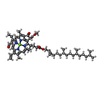 ChemComp-CHL:  ChemComp-CLA: 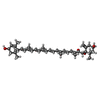 ChemComp-IWJ: 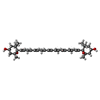 ChemComp-XAT:  ChemComp-LHG: 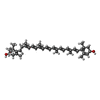 ChemComp-Q6L:  ChemComp-BCR:  ChemComp-LMG:  ChemComp-SQD: 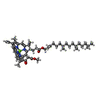 ChemComp-CL0: 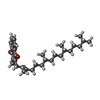 ChemComp-PQN:  ChemComp-SF4:  ChemComp-DGD: 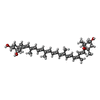 ChemComp-NEX:  ChemComp-KC2:  ChemComp-HOH: |
| Source |
|
 Keywords Keywords |  PHOTOSYNTHESIS / PHOTOSYNTHESIS /  Complex / Complex /  Electron transport / Light-harvesting Electron transport / Light-harvesting |
 Movie
Movie Controller
Controller Structure viewers
Structure viewers About Yorodumi Papers
About Yorodumi Papers




